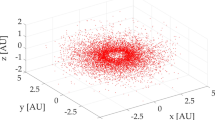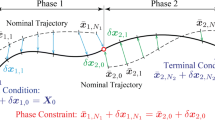Abstract
In recent years, space agencies have begun to seriously consider launching demonstration missions to test some of the asteroid orbital deflection technologies and methods that have been studied and discussed in the scientific literature. Consequently, several mission studies have already been carried out. This paper attempts to gain new insights into the target selection process by analyzing the orbital evolution of a large set of notional accessible asteroids that cover all types of Near Earth Object families. The evolution of their unperturbed orbits and their anthropogenically modified trajectories was compared, and a measure of the resilience of a given orbit to anthropogenic manipulation was taken (i.e., orbital innocuity). The results show that pruning criteria such as considering only Amor objects (i.e., non-Earth-crossers) reduce unnecessarily the population of potential suitable targets and that within large regions of Earth-crossing orbital space asteroids can be found that are both accessible and safe to manipulate from the standpoint of the Earth impact risk.











Similar content being viewed by others
Notes
Here used in the sense of the smallest Δv cost. Note however that small Δv cost is generally also indicative of long synodic periods with the Earth, and thus, for example, 2000 SG 344 is easily accessible within a very narrow range of Earth departure dates.
References
Abell, P.A., Barbee, B.W., Mink, R.G., Adamo, D.R., Alberding, C.M., Mazanek, D.D., Johnson, L.N., Yeomans, D.K., Chodas, P.W., Chamberlin, A.B., Benner, L.A.M., Drake, B.G., Friedensen, V.P.: Near-Earth Object Human Space Flight Accessible Targets Study (NHATS) (2012). http://neo.jpl.nasa.gov/nhats/
Ahrens, T.J., Harris, A.W.: Deflection and Fragmentation of Near-Earth Asteroids. Nat. 360, 429–433 (1992). doi:10.1038/360429a0
Andrea, C., Valsecchi, G.B., D’Abramo, G., Bottini, A.: Deflecting NEOs in Route of Collision with the Earth. Icarus 159, 417–422 (2002)
Battin, R.H.: Introduction to the Mathematics and Methods of Astrodynamics AIAA Education Series American Institute of Aeronautics and Astronautics Reston, Virginia (1999)
Bottke, W.F., Morbidelli, A., Jedicke, R., Petit, J.-M., Levison, H.F., Michel, P., Metcalfe, T.S.: Debiased Orbital and Absolute Magnitude Distribution of the Near-Earth Objects. Icarus 156(2), 399–433 (2002). doi:10.1006/icar.2001.6788
Brophy, J., Culick, F., Friedman, L., Allen, C., Baughman, D., Bellerose, J., et al.: Asteroid Retrieval Feasibility Study. In: Keck Institute for Space Studies, Califonia Institute of Technology, Jet Propulsion Laboratory, Pasadena, California (2012)
Carnelli, I., Galvez, A., Izzo, D.: Don Quijote: A NEO deflection precursor mission. In: NASA Workshop: Near-Earth Object Detection, Characterization, and Threat Mitigation, Vail, Colorado (2006)
Chapman, C.R.: Calibrating Asteroid Impact. Sci. 342(6162), 1051–1052 (2013). doi:10.1126/science.1246250
Dellnitz, M., Junge, O., Koon, W.S., Lekien, F., Lo, M.W., Marsden, J.E., Padberg, K., Preis, R., Ross, S.D., Thiere, B.: Transport in dynamical astronomy and multibody problems. Int. J. Bifurcation and Chaos 15(3), 699–727 (2005). doi:10.1.1.136.2804
Elvis, M.: Let’s mine asteroids – for science and profit. Nat. 485(7400), 549 (2012). doi:10.1038/485549a
Galvez, A., Carnelli, I.: Learning to Deflect Near Earth Objects: Industrial Design of the Don Quijote Mission. Paper presented at the 57th International Astronautical Congress, Valencia, Spain
García Yárnoz, D., Sanchez, J.P., McInnes, C.R.: Easily retrievable objects among the NEO population (2013)
Greenstreet, S., Ngo, H., Gladman, B.: The orbital distribution of Near-Earth Objects inside Earth’s orbit. Icarus 217(1), 355–366 (2012). doi:10.1016/j.icarus.2011.11.010
Harris, A.W., Benz, W., Fitzsimmons, A., Green, S.F., Michel, P., Valsecchi, G.B.: Target Selection for the Don Quijote Mission. In: ESA (2005)
Hernandez, S., Barbee, B.W., Bhaskaran, S., Getzandanner, K.: Mission opportunities for the flight validation of the kinetic impactor concept for asteroid deflection. Acta Astronaut 103(0), 309–321 (2014). doi:10.1016/j.actaastro.2014.04.013
Landau, D., Dankanich, J., Strange, N., Bellerose, J., Llanos, P., Tantardini, M.: Trajectories to Nab a NEA (Near-Earth Asteroid). Paper presented at the AAS/AIAA 23rd Space Flight Mechanics Meeting, Kauai, Hawaii
Milisavljevic, S.: The Proximities of Asteroids and Critical Points of the Distance Function. SerAJ (2010). doi:10.2298/SAJ1080091M
Murdoch N. (ed.): Asteroid Impact and Deflection Assessment (AIDA) Mission (2012)
Opik, E.J.: Collision Probabilities with the Planets and the Distribution of Interplanetary Matter P. Roy. Irish Acad. 54, 165–199 (1951)
Pitz, A., Kaplinger, B., Vardaxis, G., Winkler, T., Wie, B.: Conceptual design of a hypervelocity asteroid intercept vehicle (HAIV) and its flight validation mission. Acta Astronaut 94(1), 42–56 (2014). doi:10.1016/j.actaastro.2013.07.035
Popova, O.P., Jenniskens, P., Emel’yanenko, V., Kartashova, A., Biryukov, E., Khaibrakhmanov, S., Shuvalov, V., Rybnov, Y., Dudorov, A., Grokhovsky, V.I., Badyukov, D.D., Yin, Q.-Z., Gural, P.S., Albers, J., Granvik, M., Evers, L.G., Kuiper, J., Kharlamov, V., Solovyov, A., Rusakov, Y.S., Korotkiy, S., Serdyuk, I., Korochantsev, A.V., Larionov, M.Y., Glazachev, D., Mayer, A.E., Gisler, G., Gladkovsky, S.V., Wimpenny, J., Sanborn, M.E., Yamakawa, A., Verosub, K.L., Rowland, D.J., Roeske, S., Botto, N.W., Friedrich, J.M., Zolensky, M.E., Le, L., Ross, D., Ziegler, K., Nakamura, T., Ahn, I., Lee, J.I., Zhou, Q., Li, X.-H., Li, Q.-L., Liu, Y., Tang, G.-Q., Hiroi, T., Sears, D., Weinstein, I.A., Vokhmintsev, A.S., Ishchenko, A.V., Schmitt-Kopplin, P., Hertkorn, N., Nagao, K., Haba, M.K., Komatsu, M., Mikouchi, T.: Chelyabinsk Airburst, Damage Assessment, Meteorite Recovery, and Characterization. Sci. 342(6162), 1069–1073 (2013). doi:10.1126/science.1242642
Ren, Y., Masdemont, J.J., Gómez, G., Fantino, E.: Two mechanisms of natural transport in the Solar System. Commun. Nonlinear Sci. Numer. Simul. 17(2), 844–853 (2012). doi:10.1016/j.cnsns.2011.06.030
Ross, S.D., Scheeres, D.J.: Multiple Gravity Assists, Capture, and Escape in the Restricted Three-Body Problem. doi:10.1137/060663374, vol. 6, pp. 576–596 (2007)
Sanchez, J.-P., McInnes, C.: Available Asteroid Resources in the Earth’s Neighbourhood. In: Badescu, V. (ed.) Asteroids. pp. 439-458. Springer Berlin Heidelberg (2013)
Sanchez, J.P., Alessi, E.M., García Yárnoz, D., McInnes, C.: Earth Resonant Gravity Assists for Asteroid Retrieval Missions. Paper presented at the 64th International Astronautical Congress Beijing, China
Sanchez, J.P., Colombo, C.: Impact Hazard Protection Efficiency by a Small Kinetic Impactor (2013)
Sanchez, J.P., Colombo, C., Vasile, M., Radice, G.: Multi-criteria Comparison among Several Mitigation Strategies for Dangerous Near Earth Objects. doi:10.2514/1.36774, vol. 32, pp. 121–142 (2009)
Shapiro, I.I., A’Hearn, M., Vilas, F., Cheng, A.F., Culbertson, F., Jewitt, D.C., Macwell, S., Melosh, H.J., Rothenberg, J.H.: Defending Planet Earth: Near-Earth Object Surveys and Hazard Mitigation Strategies. In: p. 153. National Research Council, Washington, D.C. (2010)
Stuart, J.S.: Observational constraints on the number, albedos, size, and impact hazards of the near-Earth asteroids. Massachusetts Institute of Technology (2003)
Vasile, M., Colombo, C.: Optimal Impact Strategies for Asteroid Deflection, vol. 31, pp. 858–872 (2008), doi:10.2514/1.33432
Vasile, M., Gibbings, A., Vetrisano, M., Sanchez Cuartielles, J.P., García Yárnoz, D., Burns, D., Hopkins, J.M., McInnes, C., Colombo, C., Eckersley, S., Wayman, A., Branco, J., Di Sotto, E., Guerreiro, L.: Light Touch2: Effective Solutions to Asteroid Manipulation. In: European Space Agency (2013a)
Vasile, M., Vetrisano, M., Gibbings, A., Garcia Yarnoz, D., Sanchez, J.P., Hopkins, J.M., Burns, D., McInnes, C., Colombo, C., Branco, J., Wayman, A., Eckersley, S.: Light-touch2 : a laser-based solution for the deflection, manipulation and exploitation of small asteroids. In: IAA Planetary Defense Conference, Flagstaff, USA 2013b. IAA (2013b)
Winkler, T., Wagner, S., Wie, B.: Optimal Target Selection for a Planetary Defense Technology (PDT) Demonstration Mission. In: 22nd AAS/AIAA Space Flight Mechanics Meeting, Charleston, South Carolina 2012. AAS/AIAA
Acknowledgments
The work reported was supported by the Marie Curie grant 330649 (AsteroidRetrieval). The author would also like to thank E.M. Alessi and four anonymous reviewers for their valuable comments, insights and critiques on the manuscript.
Author information
Authors and Affiliations
Corresponding author
Rights and permissions
About this article
Cite this article
Sanchez, J.P. Asteroid Target Selection and Orbital Manipulation Sensitivity for Deflection Demonstration Missions. J of Astronaut Sci 62, 125–147 (2015). https://doi.org/10.1007/s40295-015-0046-0
Published:
Issue Date:
DOI: https://doi.org/10.1007/s40295-015-0046-0




